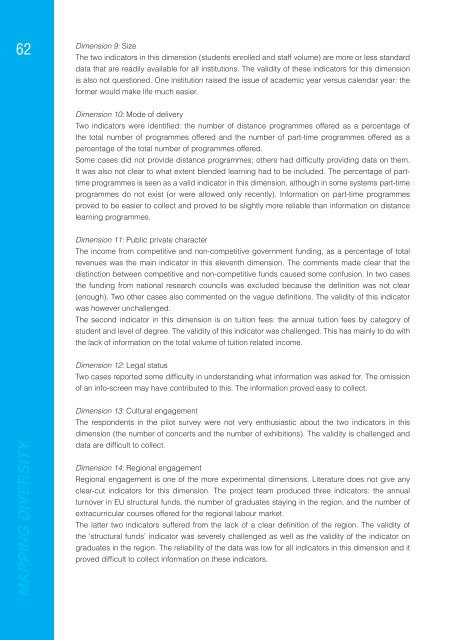Mapping Diversity: Developing a European Classification of ... - U-Map
Mapping Diversity: Developing a European Classification of ... - U-Map
Mapping Diversity: Developing a European Classification of ... - U-Map
Create successful ePaper yourself
Turn your PDF publications into a flip-book with our unique Google optimized e-Paper software.
Dimension 9: Size<br />
62<br />
The two indicators in this dimension (students enrolled and staff volume) are more or less standard<br />
data that are readily available for all institutions. The validity <strong>of</strong> these indicators for this dimension<br />
is also not questioned. One institution raised the issue <strong>of</strong> academic year versus calendar year: the<br />
former would make life much easier.<br />
Dimension 10: Mode <strong>of</strong> delivery<br />
Two indicators were identifi ed: the number <strong>of</strong> distance programmes <strong>of</strong>fered as a percentage <strong>of</strong><br />
the total number <strong>of</strong> programmes <strong>of</strong>fered and the number <strong>of</strong> part-time programmes <strong>of</strong>fered as a<br />
percentage <strong>of</strong> the total number <strong>of</strong> programmes <strong>of</strong>fered.<br />
Some cases did not provide distance programmes; others had diffi culty providing data on them.<br />
It was also not clear to what extent blended learning had to be included. The percentage <strong>of</strong> parttime<br />
programmes is seen as a valid indicator in this dimension, although in some systems part-time<br />
programmes do not exist (or were allowed only recently). Information on part-time programmes<br />
proved to be easier to collect and proved to be slightly more reliable than information on distance<br />
learning programmes.<br />
Dimension 11: Public private character<br />
The income from competitive and non-competitive government funding, as a percentage <strong>of</strong> total<br />
revenues was the main indicator in this eleventh dimension. The comments made clear that the<br />
distinction between competitive and non-competitive funds caused some confusion. In two cases<br />
the funding from national research councils was excluded because the defi nition was not clear<br />
(enough). Two other cases also commented on the vague defi nitions. The validity <strong>of</strong> this indicator<br />
was however unchallenged.<br />
The second indicator in this dimension is on tuition fees: the annual tuition fees by category <strong>of</strong><br />
student and level <strong>of</strong> degree. The validity <strong>of</strong> this indicator was challenged. This has mainly to do with<br />
the lack <strong>of</strong> information on the total volume <strong>of</strong> tuition related income.<br />
Dimension 12: Legal status<br />
Two cases reported some diffi culty in understanding what information was asked for. The omission<br />
<strong>of</strong> an info-screen may have contributed to this. The information proved easy to collect.<br />
MAPPING DIVERSITY<br />
Dimension 13: Cultural engagement<br />
The respondents in the pilot survey were not very enthusiastic about the two indicators in this<br />
dimension (the number <strong>of</strong> concerts and the number <strong>of</strong> exhibitions). The validity is challenged and<br />
data are diffi cult to collect.<br />
Dimension 14: Regional engagement<br />
Regional engagement is one <strong>of</strong> the more experimental dimensions. Literature does not give any<br />
clear-cut indicators for this dimension. The project team produced three indicators: the annual<br />
turnover in EU structural funds, the number <strong>of</strong> graduates staying in the region, and the number <strong>of</strong><br />
extracurricular courses <strong>of</strong>fered for the regional labour market.<br />
The latter two indicators suffered from the lack <strong>of</strong> a clear defi nition <strong>of</strong> the region. The validity <strong>of</strong><br />
the ‘structural funds’ indicator was severely challenged as well as the validity <strong>of</strong> the indicator on<br />
graduates in the region. The reliability <strong>of</strong> the data was low for all indicators in this dimension and it<br />
proved diffi cult to collect information on these indicators.

















